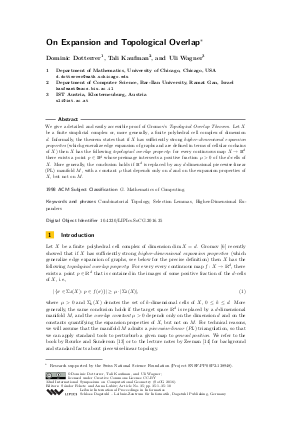On Expansion and Topological Overlap
Authors Dominic Dotterrer, Tali Kaufman, Uli Wagner
-
Part of:
Volume:
32nd International Symposium on Computational Geometry (SoCG 2016)
Part of: Series: Leibniz International Proceedings in Informatics (LIPIcs)
Part of: Conference: Symposium on Computational Geometry (SoCG) - License:
 Creative Commons Attribution 3.0 Unported license
Creative Commons Attribution 3.0 Unported license
- Publication Date: 2016-06-10
File

PDF
LIPIcs.SoCG.2016.35.pdf
- Filesize: 0.51 MB
- 10 pages
Document Identifiers
Subject Classification
Keywords
- Combinatorial Topology
- Selection Lemmas
- Higher-Dimensional Expanders
Metrics
- Access Statistics
-
Total Accesses (updated on a weekly basis)
0PDF Downloads0Metadata Views
Abstract
We give a detailed and easily accessible proof of Gromov's Topological Overlap Theorem. Let X be a finite simplicial complex or, more generally, a finite polyhedral cell complex of dimension d. Informally, the theorem states that if X has sufficiently strong higher-dimensional expansion properties (which generalize edge expansion of graphs and are defined in terms of cellular cochains of X) then X has the following topological overlap property: for every continuous map X -> R^d there exists a point p in R^d whose preimage intersects a positive fraction mu > 0 of the d-cells of X. More generally, the conclusion holds if R^d is replaced by any d-dimensional piecewise-linear (PL) manifold M, with a constant \mu that depends only on d and on the expansion properties of X, but not on M.
Cite As Get BibTex
Dominic Dotterrer, Tali Kaufman, and Uli Wagner. On Expansion and Topological Overlap. In 32nd International Symposium on Computational Geometry (SoCG 2016). Leibniz International Proceedings in Informatics (LIPIcs), Volume 51, pp. 35:1-35:10, Schloss Dagstuhl – Leibniz-Zentrum für Informatik (2016)
https://doi.org/10.4230/LIPIcs.SoCG.2016.35
BibTex
@InProceedings{dotterrer_et_al:LIPIcs.SoCG.2016.35,
author = {Dotterrer, Dominic and Kaufman, Tali and Wagner, Uli},
title = {{On Expansion and Topological Overlap}},
booktitle = {32nd International Symposium on Computational Geometry (SoCG 2016)},
pages = {35:1--35:10},
series = {Leibniz International Proceedings in Informatics (LIPIcs)},
ISBN = {978-3-95977-009-5},
ISSN = {1868-8969},
year = {2016},
volume = {51},
editor = {Fekete, S\'{a}ndor and Lubiw, Anna},
publisher = {Schloss Dagstuhl -- Leibniz-Zentrum f{\"u}r Informatik},
address = {Dagstuhl, Germany},
URL = {https://drops.dagstuhl.de/entities/document/10.4230/LIPIcs.SoCG.2016.35},
URN = {urn:nbn:de:0030-drops-59270},
doi = {10.4230/LIPIcs.SoCG.2016.35},
annote = {Keywords: Combinatorial Topology, Selection Lemmas, Higher-Dimensional Expanders}
}
